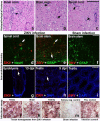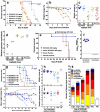Efficacy of the broad-spectrum antiviral compound BCX4430 against Zika virus in cell culture and in a mouse model
- PMID: 27838352
- PMCID: PMC5215849
- DOI: 10.1016/j.antiviral.2016.11.003
Efficacy of the broad-spectrum antiviral compound BCX4430 against Zika virus in cell culture and in a mouse model
Abstract
Zika virus (ZIKV) is currently undergoing pandemic emergence. While disease is typically subclinical, severe neurologic manifestations in fetuses and newborns after congenital infection underscore an urgent need for antiviral interventions. The adenosine analog BCX4430 has broad-spectrum activity against a wide range of RNA viruses, including potent in vivo activity against yellow fever, Marburg and Ebola viruses. We tested this compound against African and Asian lineage ZIKV in cytopathic effect inhibition and virus yield reduction assays in various cell lines. To further evaluate the efficacy in a relevant animal model, we developed a mouse model of severe ZIKV infection, which recapitulates various human disease manifestations including peripheral virus replication, conjunctivitis, encephalitis and myelitis. Time-course quantification of viral RNA accumulation demonstrated robust viral replication in several relevant tissues, including high and persistent viral loads observed in the brain and testis. The presence of viral RNA in various tissues was confirmed by an infectious culture assay as well as immunohistochemical staining of tissue sections. Treatment of ZIKV-infected mice with BCX4430 significantly improved outcome even when treatment was initiated during the peak of viremia. The demonstration of potent activity of BCX4430 against ZIKV in a lethal mouse model warrant its continued clinical development.
Keywords: AG129 mice; Antiviral; BCX4430; Flavivirus; Ribavirin; ZIKV; Zika virus.
Copyright © 2016 Elsevier B.V. All rights reserved.
Figures




Similar articles
-
Antiviral activity of N-(4-hydroxyphenyl) retinamide (4-HPR) against Zika virus.Antiviral Res. 2017 Nov;147:124-130. doi: 10.1016/j.antiviral.2017.10.014. Epub 2017 Oct 16. Antiviral Res. 2017. PMID: 29051080 Free PMC article.
-
BCX4430 - A broad-spectrum antiviral adenosine nucleoside analog under development for the treatment of Ebola virus disease.J Infect Public Health. 2016 May-Jun;9(3):220-6. doi: 10.1016/j.jiph.2016.04.002. Epub 2016 Apr 16. J Infect Public Health. 2016. PMID: 27095300 Free PMC article. Review.
-
A Viral Polymerase Inhibitor Reduces Zika Virus Replication in the Reproductive Organs of Male Mice.Int J Mol Sci. 2019 Apr 29;20(9):2122. doi: 10.3390/ijms20092122. Int J Mol Sci. 2019. PMID: 31032814 Free PMC article.
-
Ribavirin inhibits Zika virus (ZIKV) replication in vitro and suppresses viremia in ZIKV-infected STAT1-deficient mice.Antiviral Res. 2017 Oct;146:1-11. doi: 10.1016/j.antiviral.2017.08.007. Epub 2017 Aug 14. Antiviral Res. 2017. PMID: 28818572 Free PMC article.
-
An update on the progress of galidesivir (BCX4430), a broad-spectrum antiviral.Antiviral Res. 2021 Nov;195:105180. doi: 10.1016/j.antiviral.2021.105180. Epub 2021 Sep 20. Antiviral Res. 2021. PMID: 34551346 Free PMC article. Review.
Cited by
-
Potential Anti-SARS-CoV-2 Therapeutics That Target the Post-Entry Stages of the Viral Life Cycle: A Comprehensive Review.Viruses. 2020 Sep 26;12(10):1092. doi: 10.3390/v12101092. Viruses. 2020. PMID: 32993173 Free PMC article. Review.
-
A gossypol derivative effectively protects against Zika and dengue virus infection without toxicity.BMC Biol. 2022 Jun 15;20(1):143. doi: 10.1186/s12915-022-01344-w. BMC Biol. 2022. PMID: 35706035 Free PMC article.
-
Advances in antiviral strategies targeting mosquito-borne viruses: cellular, viral, and immune-related approaches.Virol J. 2025 Feb 4;22(1):26. doi: 10.1186/s12985-025-02622-z. Virol J. 2025. PMID: 39905499 Free PMC article. Review.
-
Modalities and Mechanisms of Treatment for Coronavirus Disease 2019.Front Pharmacol. 2021 Feb 8;11:583914. doi: 10.3389/fphar.2020.583914. eCollection 2020. Front Pharmacol. 2021. PMID: 33643033 Free PMC article. Review.
-
Dengue and Zika Viruses: Epidemiological History, Potential Therapies, and Promising Vaccines.Trop Med Infect Dis. 2020 Sep 23;5(4):150. doi: 10.3390/tropicalmed5040150. Trop Med Infect Dis. 2020. PMID: 32977703 Free PMC article. Review.
References
-
- Araujo LM, Ferreira ML, Nascimento OJ. Guillain-Barre syndrome associated with the Zika virus outbreak in Brazil. Arq Neuropsiquiatr. 2016;74:253–255. - PubMed
-
- Brocklehurst P, Volmink J. Antiretrovirals for reducing the risk of mother-to-child transmission of HIV infection. Cochrane Database Syst Rev. 2002:CD003510. - PubMed
-
- Cooper ER, Charurat M, Mofenson L, Hanson IC, Pitt J, Diaz C, Hayani K, Handelsman E, Smeriglio V, Hoff R, Blattner W, Women, Infants' Transmission Study, G. Combination antiretroviral strategies for the treatment of pregnant HIV-1-infected women and prevention of perinatal HIV-1 transmission. J Acquir Immune Defic Syndr. 2002;29:484–494. - PubMed
-
- Cordeiro MT, Pena LJ, Brito CA, Gil LH, Marques ET. Positive IgM for Zika virus in the cerebrospinal fluid of 30 neonates with microcephaly in Brazil. Lancet. 2016;387:1811–1812. - PubMed
MeSH terms
Substances
Grants and funding
LinkOut - more resources
Full Text Sources
Other Literature Sources
Medical

